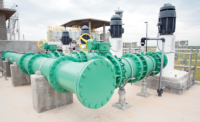"What was really challenging about this project was that it's all regulatory based," says Stan Williams, project manager for HDR. "The growth in the Houston area just skyrocketed, and everything was supported on groundwater. They noticed that the aquifers were dropping and that growth was no longer sustainable."
To counter the problem, the county put regulations in place restricting how much groundwater local entities can use.
"The project combines several benefits—economies of scale, regionalization and conjunctive use of multiple sources of water. It's very unusual to have all of these benefits in a single project," Kelling says.
SJRA owns and operates Lake Conroe, located right in the middle of the county, making surface water the obvious solution. However, SJRA had no surface water treatment division and no surface water treatment infrastructure at the lake. "They just had the water," Williams says. "So they put out feelers to see who wanted to join up and be part of the program, and 140 different entities signed up for the estuary program throughout the county."
Kelling notes that the SJRA organization, including its work processes, was effectively rebuilt from top to bottom to deliver the GRP program for Montgomery County efficiently and effectively.
These regulations have made the project time line extremely tight as well. The GRP has a deadline of 2016, when a certain portion of drinking water can no longer be groundwater, O'Donnell explains. "The owner really has a fixed deadline to be able to deliver water. So as part of the CMAR process, we were able to put out early works packages with some of the things that weren't even completely designed yet, but to get the ball rolling so that we could meet the owner's dates," he says.
Extensive testing, Design
Initial work on the Surface Water Facilities began in 2010 when HDR was working on a smaller scale, 100-sq-ft pilot plant made necessary by the lack of resources available in the county.
"We developed a very comprehensive pilot plant where we tested 14 different process trains and evaluated against 13 different evaluation criteria we came up with," Williams says. "It was extremely involved. I've never seen any that have tested that many different treatment trains. I've seen maybe three or four."
The testing process, including establishing and receiving approval on protocols, pilot plant testing and test procedure approval took a little over a year, after which the design of the plant began.











Post a comment to this article
Report Abusive Comment